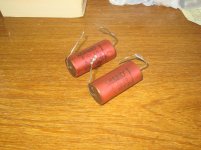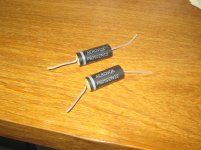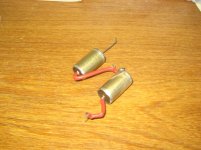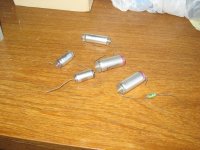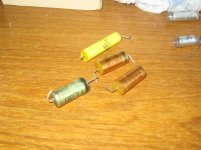Hi Everyone,
I posted elsewhere how yesterday I lucked out in the Elec. Eng. storeroom, and found some cool wirewound 10-turn pots to use in some BF862 preamps I'm putting together. The idea is to use up extra boards I made, and to experiment a little, have a little fun; if the results sound good, give them away to friends or something. Anyway, I decided to go back today and see if I could find some film capacitors to use on the outputs, hoping to find 10uF or 6.8uF polyester or something like that. No luck with those, but at the bottom of an unbelievably dirty box of NOS/used/surplus caps I found a selection of things that are pretty cool-looking, that would be fun to try. None of them are large enough to be output caps by themselves; I was thinking more of putting them in parallel with something larger. All of the caps in the photos below measure within spec on a capacitance meter, but I'm not sure exactly what some of them are made of, or which would be fun to try on the outputs of the preamps. So, I'd like to hear from anyone who knows what they are, or has a suggestion of something that would be fun to try out with them. (Or if they should be saved for some better function...)
Photo 1: These are about 2" long by 3/4" in diameter, marked 0.5uF, "Cherry" "a oleo" which is clearly an oil cap, so are they likely paper-in-oil? Or what?
Photo 2: These are also 0.5uF, "Aerovox" brand. What might these be made of? They are the newest looking of the lot.
Photo 3: Here I'm clueless. I have a couple of pairs, different values, marked "Wima" and "Durolit". Ideas?
Photo 4: These I'm quite excited about. I have quite a dozen or so (in pairs), all sorts of values ranging up to 10nF and 13nF. Some are marked "MIAL". My best gues is that they are polystyrene, which would be pretty cool. Some have a faint pink ring around one end - this doesn't mean they're polarised, surely?
Photo 5: My best guess is these are metallised polypropylene, or mylar. At least, the yellow ones. What would your best guesses be?
OK, I can play around with these to my heart's content without incurring any cost, but it would be fun to hear suggestions, and especially if anyone can give info about them.
Cheers
Nigel
I posted elsewhere how yesterday I lucked out in the Elec. Eng. storeroom, and found some cool wirewound 10-turn pots to use in some BF862 preamps I'm putting together. The idea is to use up extra boards I made, and to experiment a little, have a little fun; if the results sound good, give them away to friends or something. Anyway, I decided to go back today and see if I could find some film capacitors to use on the outputs, hoping to find 10uF or 6.8uF polyester or something like that. No luck with those, but at the bottom of an unbelievably dirty box of NOS/used/surplus caps I found a selection of things that are pretty cool-looking, that would be fun to try. None of them are large enough to be output caps by themselves; I was thinking more of putting them in parallel with something larger. All of the caps in the photos below measure within spec on a capacitance meter, but I'm not sure exactly what some of them are made of, or which would be fun to try on the outputs of the preamps. So, I'd like to hear from anyone who knows what they are, or has a suggestion of something that would be fun to try out with them. (Or if they should be saved for some better function...)
Photo 1: These are about 2" long by 3/4" in diameter, marked 0.5uF, "Cherry" "a oleo" which is clearly an oil cap, so are they likely paper-in-oil? Or what?
Photo 2: These are also 0.5uF, "Aerovox" brand. What might these be made of? They are the newest looking of the lot.
Photo 3: Here I'm clueless. I have a couple of pairs, different values, marked "Wima" and "Durolit". Ideas?
Photo 4: These I'm quite excited about. I have quite a dozen or so (in pairs), all sorts of values ranging up to 10nF and 13nF. Some are marked "MIAL". My best gues is that they are polystyrene, which would be pretty cool. Some have a faint pink ring around one end - this doesn't mean they're polarised, surely?
Photo 5: My best guess is these are metallised polypropylene, or mylar. At least, the yellow ones. What would your best guesses be?
OK, I can play around with these to my heart's content without incurring any cost, but it would be fun to hear suggestions, and especially if anyone can give info about them.
Cheers
Nigel
Attachments
Hi SY,
Not even to experiment with? I thought I could play around a bit with some of these, see what happens...
OK, but isn't that all true of new ones also? And is my guess correct that they're polystyrene?
Well, I was concerned with leaks also, but I thought the ones that measure OK would be worth giving a try to... And there's certainly no need to be sorry - on the contrary, thanks for replying...
Cheers
Nigel
I wouldn't put any of them in any gear I cared about.
Not even to experiment with? I thought I could play around a bit with some of these, see what happens...
ESPECIALLY those horrible little polystyrene caps. Inductive, temperature sensitive, and failure-prone. They often die during soldering.
OK, but isn't that all true of new ones also? And is my guess correct that they're polystyrene?
Old paper caps are likely to be leaky and have pretty poor characteristics.
Sorry.
Well, I was concerned with leaks also, but I thought the ones that measure OK would be worth giving a try to... And there's certainly no need to be sorry - on the contrary, thanks for replying...
Cheers
Nigel
Hi bear,
Thanks for the reply.
Thanks for the info. Actually the ones that look best are the "Aerovox" in the second photo... I don't suppose you know what they are, by any chance?
The main reason for trying these out was just to see if I can hear any difference in sound, without spending a lot of money. I am something of a sceptic about the sound of capacitors, but the only way to find out for sure is to try them, right? On the other hand, if any of these wouldn't be a fair test then there's no point... The only film caps I can get here are polyester, and not always a reliable brand either, so I was thinking of maybe trying some of these out in parallel with 4.7 uF or 6.8uF polyesters (Epcos if I can get them) as output caps on a preamp.
Actually I saw someone else suggesting this, and I have had my eyes open for one (or more), but due to some very odd Brazilian buraecracy I am not likely to get any from the university, unless I was willing to bid in a public auction for a couple of hundred of them. I think my wife might be a little upset, to say the least, if I filled the living room with a couple of hundred CRT montors....
Cheers
Nigel
Thanks for the reply.
I don't know what SY has against polystyrenes...
The last photo shows a few mylars, ok to use.
Thanks for the info. Actually the ones that look best are the "Aerovox" in the second photo... I don't suppose you know what they are, by any chance?
The main reason for trying these out was just to see if I can hear any difference in sound, without spending a lot of money. I am something of a sceptic about the sound of capacitors, but the only way to find out for sure is to try them, right? On the other hand, if any of these wouldn't be a fair test then there's no point... The only film caps I can get here are polyester, and not always a reliable brand either, so I was thinking of maybe trying some of these out in parallel with 4.7 uF or 6.8uF polyesters (Epcos if I can get them) as output caps on a preamp.
You want free parts?? Find some thrown out computer monitors, take the boards out of them, chock full of excellent parts. Literally full.
_-_-bear
Actually I saw someone else suggesting this, and I have had my eyes open for one (or more), but due to some very odd Brazilian buraecracy I am not likely to get any from the university, unless I was willing to bid in a public auction for a couple of hundred of them. I think my wife might be a little upset, to say the least, if I filled the living room with a couple of hundred CRT montors....
Cheers
Nigel
I don't know what SY has against polystyrenes...
Those particular types of PS caps are notoriously inductive and unreliable. One can make a good PS cap, those just aren't among them.
If memory serves, Allen Wright was also down on these- he slammed them pretty hard in his preamp book.
Those particular types of PS caps are notoriously inductive and unreliable.
If they're unreliable and easily damaged (and I have no reason to doubt your opinion) then trying them out wouldn't be a fair test of polystyrene caps. This takes a lot of the fun out of trying them out, so I'll probably drop them.
One can make a good PS cap, those just aren't among them.
So maybe best to leave the test for when I have some of these...
The other caps are a different isssue, however. For instance, the old "a oleo" caps measure on spec - if they had leaked wouldn't their capacitance alter? (That's meant as a genuine question - not meant to be rhetorical...) And the "Aerovox" caps really look like new, and also measure correctly...
Cheers
Nigel
...with more specialized tools, you could measure leakage current.
Just goes to show how strangely minds can work... Speaking of "a oleo" (or "in oil") caps, I assumed (without thinking) that when you originally described them as "leaky" you meant leaking (or having leaked) oil... Like people always used to say about British sports cars. But you actually meant "leaky" in an electrical sense, right?
Oh my, do I have stuff to learn...
Thanks again for the help
Nigel
- Status
- This old topic is closed. If you want to reopen this topic, contact a moderator using the "Report Post" button.
- Home
- Amplifiers
- Pass Labs
- What are, and what to do with, these NOS/used caps?
